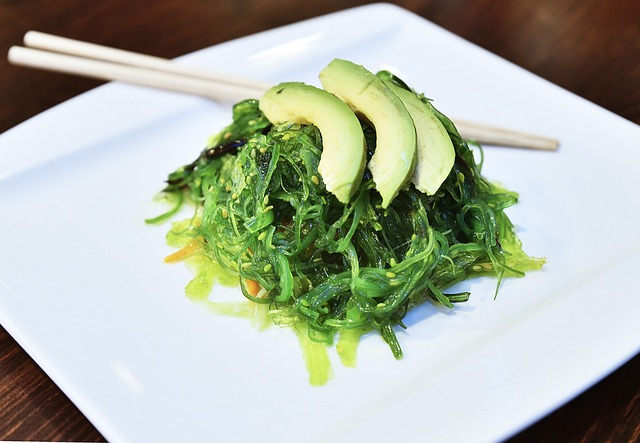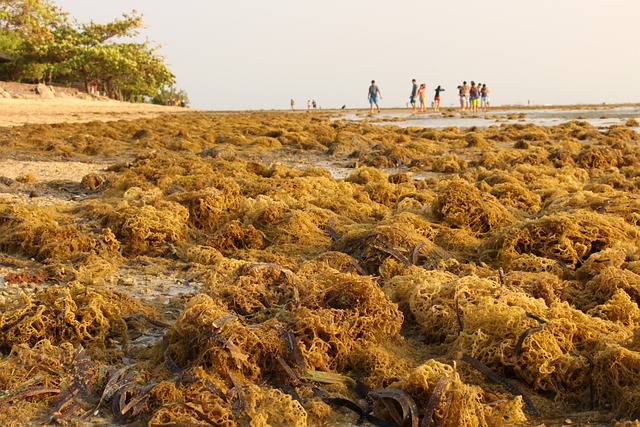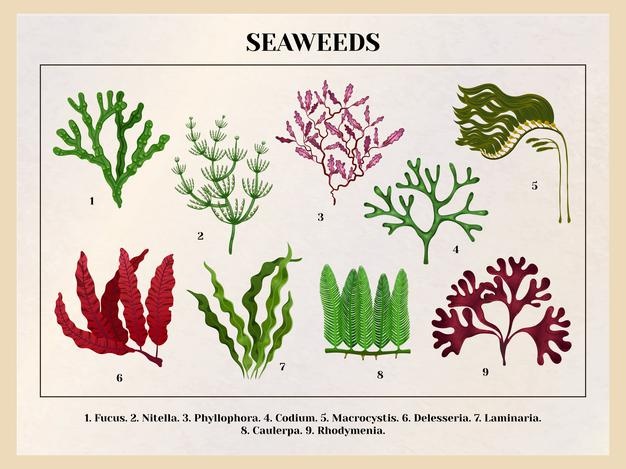In order to increase the supply of seaweed in the country, the rural population of Rameswaram (Tamilnadu) is empowered through seaweed cultivation and processing by the joint effort of CSIR-CSMCRI. Seaweed cultivation is undertaken in marine and shallow coastal waters of maritime states and on rocky shores, wherein Tube-Nets or Bamboo-Rafts would be held in clusters. The process of seaweed cultivation is eco-friendly, without any use of inorganic inputs or chemicals.
Seaweed farming is an emerging sector with great potential to transform the lives of coastal communities and it will also provide large employment opportunities and additional income sources.
There are around 844 species of seaweeds have been reported from Indian seas, with an estimated wet weight of about 58,715 tons. Out of the 844 seaweed species, India possesses around 434 species of Red Algae, 216 species of Green Algae, and 194 species of Brown Algae.
Seaweed Mariculture is an economically viable livelihood option for the coastal fishing community in India, especially for the fisherwomen. The fisherfolk takes four bamboo logs and ties them to make a raft or a frame, using strings and small pieces of seaweed. The task of tying the seaweed can be done by either men or women, therefore making the process of cultivation gender-neutral.
# The Red Algae Gracilaria dura, Gracilaria edulis, and Kappaphycus alvarezii are highly suitable for cultivation on floating Tube Nets or Bamboo Rafts held in the sea.
Seaweed can be grown in different ways, but the most common technique which is used in India is using the Single Rope Floating Raft method (Coir Rope & Nylon Rope). It involves the building of bamboo rafts and spreading them out in the sea. Other techniques of cultivation are the Fixed Bottom long line method (Coir Rope & Nylon Rope) and the Integrated Multi Trophic Aquaculture (IMTA) method.
Important points:
- Seaweeds were rich in vitamins, minerals, trace elements, and bioactive substances.
- The green seaweeds Ulva, Codium, Enteromorpha, and Caulerpa are used exclusively as sources of food i.e., they are either eaten as fresh salads or cooked as vegetables along with rice.
- The major industrial applications of seaweeds are as a source of agarose, agar, and carrageenan used in laboratories, cosmetics, paint, cardboard, paper, pharmaceuticals, and processed foods.
- Currently, there are 46 seaweed-based industries in India.
- Marine Algal Research Station is located at Mandapam in Tamil Nadu.
- Central Salt and Marine Chemicals Research Institute (CSMCRI), Bhavnagar, Gujarat
- China is the largest producer of edible seaweeds in the world.
- Seaweeds are abundant along the Tamil Nadu and Gujarat coasts and also around Andaman & Nicobar Islands and Lakshadweep.
- Rich seaweed beds occur around Ratnagiri, Goa, Mumbai, Karwar, Vizhinjam, Varkala, and Pulicat in Tamil Nadu, Andhra Pradesh, and Chilka in Orissa.
- The Red Algae Gracilaria edulis, Gelidiella verrucosa, Gelidiella foliifera Gelidiella acerosa, and Gelidiella crassa are used in manufacturing Agar and Turbinaria spp., Brown Algae Sargassum spp., and Cystoseira trinodis for the production of alginates and liquid seaweed fertilizer.
- CSIR full form-Council of Scientific and Industrial Research.
What are Seaweeds?
Seaweeds are macroscopic algae. They are wonderful plants of the sea, the new renewable source of food, energy, medicines, and chemicals with manifold nutritional, biomedical, industrial, agriculture, health, textiles, animal feed, and personal care applications. Seaweed cultivation is a highly remunerative activity that involves simple, easy, low-cost, low maintenance technology with a short grow-out cycle.
Seaweeds are primitive types of plants lacking true roots, leaves, and stems. The root system and conducting tissues like land plants are absent in seaweeds. They are also termed as the ‘Medical Food of the 21st Century’ because of their usage as laxatives. They are also used for making pharmaceutical capsules for the treatment of goiter, bone-replacement therapy, cancer, and cardiovascular surgeries. Because of its numerous uses, seaweed as a product is highly in demand all over the world.
Seaweeds are grouped into four types according to their pigments that absorb light of particular wavelengths that give them their colors like blue, green, red, and brown.
- The Phaeophyta ( Brown algae)
- The Rhodophyta ( Red algae)
- The Chlorophyta ( Green algae)
Role of CSIR-CSMCRI in Seaweed Cultivation:
The local coastal fisher population has been cultivating Seaweed for a long time but they lacked the required skills necessary for harnessing its full potential. This is the reason why CSIR-CSMCRI had stepped in and took up the initiative to impart the necessary skills. They have helped the locals to develop skills in cultivating seaweed, enhancing biomass productivity of seaweeds for industrial requirements, employing appropriate technology, and encouraging entrepreneurship development on seaweed-based activities. They have also trained many community-based organizations, Self Help Groups, and many women in Mandapam, Tamil Nadu, and Gujarat, who are now the breadwinners of their families. They are now earning good dividends through seaweed farming. Several women groups have been benefited and the capacity building through the CSIR-CSMCRI training and technology have ensured livelihood for the local population and it has also gone a long way in empowering them.
What is Carrageenan?
Carrageenan is extracted from red edible seaweed. It is widely used in the food industry for its thickening, gelling, and stabilizing properties. It is popularly used in dairy and meat products, due to its strong binding to food proteins. It is also used in pickles, jellies, ice cream mixes, and as a clarifying agent in beverages.
Budget 2021:
- The Union Finance Minister Nirmala Sitharaman has recently proposed to set up a multi-purpose seaweed park in Tamil Nadu as part of promoting seaweed cultivation in the country.
Conclusion:
- Seed stock of seaweeds is traditionally collected from the sea beds in the shallow waters along the southeastern coast of Tamil Nadu. The continuous, unorganized and indiscriminate harvesting has resulted in depletion of the natural resources.
- To fill the demand-supply gap of the Agar and Alginate producing industry in the country there should be large-scale cultivation of commercially important seaweeds in the coastal waters of maritime states.
- Farming of Red Seaweed Gracilaria dura on Gujarat Coast is also encouraged for promoting inclusive economic growth in coastal rural settings.
- Research is being carried out in some varieties of seaweed extract to treat HIV, breast cancer, and agglutinates human B-type erythrocytes in vitro.












Everything is very open with a precise explanation of the challenges. It was truly informative. Your website is very helpful. Thank you for sharing!
Thank you so much
Outstanding post, I conceive blog owners should larn a lot from this weblog its rattling user genial.
Thank you so much
Everything is very open with a very clear explanation of the challenges. It was definitely informative. Your website is extremely helpful. Thank you for sharing!
Thank you so much
Nice post i like it 100 %. I learn something new and challenging on sites I stumbleupon on a daily basis. Its always helpful to read through articles from other writers and use something from their web sites.
Thank you so much
Very nice write-up. I absolutely appreciate this site. Stick with it!
Thank you so much
I like the efforts you have put in this, appreciate it for all the great content.
Thank you
Spot on with this write-up, I really assume this website wants way more consideration. I’ll in all probability be again to learn far more, thanks for that info.
Welcome
Awesome website you have here. Cheers!
I conceive this web site contains very good written articles blog posts.
Thank you
Itís difficult to find educated people about this subject, but you sound like you know what youíre talking about! Thanks
I need to to thank you for this fantastic read!!
I certainly loved every bit of it. I have got you book-marked
Very informative. Can seaweeds be grown in rivers?. I have seen many such weeds in Gomti river in Lucknow. Kindly advise how to identify them. Jitendra. 919334851224
Good. I should definitely say, impressed with your site. I had no trouble navigating through all tabs and related information ended up being truly easy to do to access. Excellent task..
Thank you
Thankyou for this post, I am a big big fan of this internet site would like to continue updated.
Thank you
Hi mam, I am a research scholar